Badagry
This article needs additional citations for verification. (October 2014) |
Badagry
Agbadarigi | |
|---|---|
Town | |
 A chair market at Badagry in 1910 | |
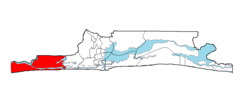 Badagry shown within the State of Lagos | |
 Badagry Location of Badagry in Nigeria | |
| Coordinates: 6°25′N 2°53′E / 6.417°N 2.883°E | |
| Country | Nigeria |
| State | Lagos State |
| LGA | Badagry |
| Government | |
| • Sole Administrator | Jacob Kent |
| Area | |
| • Total | 170 sq mi (441 km2) |
| Population (2006) | |
| • Total | 241,093 |
| Time zone | UTC+1 (WAT) |
| Website | www.badagrygov.org |
Badagry (traditionally Gbagli) also spelled Badagri,[1] is a coastal town and Local Government Area (LGA) in Lagos State, Nigeria. It is quite close to the city of Lagos, and located on the north bank of Porto Novo Creek, an inland waterway that connects Nigeria's (Lagos) and Benin's (Porto-Novo) national capitals, as well as on a route that connects Lagos, Ilaro, and Porto-Novo, and shares a border with the Republic of Benin. As of the preliminary 2006 census results, the municipality had a population of 241,093.[2]
Serving as a lagoon and an Atlantic port, Badagry emerged as a commercial center on the West African coast between 1736 and 1851.[3] Its connecting and navigable lakes, creeks and inland lagoons acted as a means to facilitate trade and as a security bar for residents. During the Trans-Atlantic slave trade, the town was a middleman between European traders on the coast and traders from the hinterland.[4]
Geography[]
Badagry is situated on the south-west coast of Nigeria, bordered by the Gulf of Guinea to the south, it is 43 miles southeast of Lagos and 32 miles west of Seme, a border town in Benin Republic.[5] Like Lagos Island, it is on the bank of inland lagoons, a system of creeks, waterways that are navigable to Lagos and Porto Novo. The distance between the lagoon and the ocean varies along the coast, in Badagry, the distance is about a mile.[5] The depth of the lagoon varies according to the season, from highs of 3 meters to lows of a meter. The lagoons have a diverse fish population that includes bonga, croaker, longfin pompano, tilapia and catfish.[6] The lagoon consists of brackish and freshwater with seasonal variability, west of Badagry, Yewa River provides water inflow to the lagoon.
History[]
There is a traditional Yoruba narrative that the first settlement within the area was an Awori group originally from Ile-Ife who lived at a nearby settlement. Robin Law, a scholar on West African history, notes an origin that sprouted out of a resettlement for displaced peoples of varied ethnic groups mostly Ogu people, Ewe people and Oyo Yorubas. Another source links the people living at a settlement called Gberefu as the Ewe's of Oyo, an island along the Atlantic coast.[5]
One of the recorded notable events in the history of the town was the acquisition of land by a European trader who was locally known as Yovo Huntokonu.[7] Many sources identify the European to be a Dutch trader called Hendrik Hertogh.[8] Huntokonu, who came from the west, settling in the area after fleeing the wrath of an African chief. He reached the settlement called Apa under the Obaship of Alapa and he was given farmland to use for trading.[8]
The name Badagry was derived from the city's indigenes' methods of subsistence, which include fishing, farming, and salt production. Others think the city was called after Agbedeh, a well-known farmer whose farm, Agbadarigi, was renamed Badagry by Europeans. Badagry served as a corridor for Europeans to carry slaves to new destinations in the early eighteenth century. Its cenotaph is called "Point of No Return," and the well at this location was charmed to make slaves who drank from it forget their fate. Badagry was one of the routes that benefited from the ongoing slave trade conflict between Portnovo and Dahomey at the end of the eighteenth century. Slaves taken during inter-villages conflict were auctioned off at Badagry.[9]
Chief Mobee was one of the African chiefs who participated in the slave trade in 1983. In Marina, Badagry, the first two-story structure was constructed in 1845.[10]
1736–1840[]
Huntokonu set up a trading post on the gifted land ca 1736, and it was after Huntokonu's settlement that Badagry emerged as a slave port, serving principally as an outlet for Oyo and displacing Apa politically and commercially.[11] During this period, political refugees fleeing aggression from King Agaja Trudo migrated to Badagry.[12] Agaja who was seeking an outlet to the sea was warring across the coast and the resulting war caused an influx of people living along the coast of Weme, , , Jaki, and Popos to settle in Badagry.[8] These group came to be known as Ogu. Each migrant group were affiliated with eight heterogeneous quarters[13] and newly arrived immigrants settled in wards related to their state of origin. [14]Badagry's wards were headed by commercial and political autonomous chiefs thereby creating a fragmented political structure.[8] This flexibility was advantageous for trade but also caused internal instability.[8]
Slave trading was not as prominent in Badagry than it was in Bonny, Angola, Ouidah, and Calabar;[15] in 1865, slaves transported out of Badagry were 800, while at Porto Novo, the figure was 1,200, and at Ouidah, up to 5,000 slaves were transported.[8] The peak period of the slave trade in the city state was between 1736 and 1789, but the trade continued into the early nineteenth century, with Portueguese or Brazilian traders taking over from the Dutch.[16]
The rise of Badagry on the coast led to hostilities with Ouidah, which combined with Oyo and Lagos to sack the town in 1784.[8][17] After the destruction, Jiwa, a political refugee from Porto-Novo took over the reins of most of the political structures between 1784 and 1788.[18] In ca 1821, Oba Adele was exiled to Badagry , he proved to be a source of leadership, and was able to make Badagry a politically independent state.[17] The founding of Abeokuta also proved beneficial to Badagry as the former made use of Badagry as an outlet for trading.[8] IAdele was involved with the famous trader, Madam Tinubu and sided with Egba's in their conflict with Ota and Ijebu.[19] Among Adele's followers from Lagos were Muslims, mostly servants from the Northern region, these group introduced Islam to the Ogu people in the city-state.[8]
After the British abolished the slave trade, notable trader Francisco Félix de Sousa migrated to Badagry around 1807.[8] Trade in ivory, cloth and palm oil were also important economic activities of residents. Thomas Hutton established a presence in Badagri in 1838, other British traders followed in subsequent years.[20] Unlike in the interior, Badagry's soil was not suitable for commercial agriculture, but farms were set up in areas surrounding the town.[21] The palm oil trade was of considerable value to Badagry and was an illegal trade in slaves directed by Brazilians. The influence of anti-slave trade raids and cession of Badagry to Britain put a stop to the trade.[8]
1840–1900[]
Badagry's location as a coastal town with links northwards to Abeokuta and Oyo made it a port of entry for emigrants from Sierra Leone and missionaries.[22] Around 1837, a settled Sierra-Leonean emigrant of the Methodist faith wrote a letter requesting a catechist in Badagry. The Methodist already had a missionary party in the Gold Coast, and some members were sent to Badagry.[22] this party was led by Thomas Birch Freeman and Charles DeGraft. The Methodist missionaries first preached under an Agia tree and later erected a make- shift bamboo Church.[23]
In 1845, a CMS missionary party arrived Badagry. In the party were Revs, Townsend, Crowther and Gollmer, two teachers from Sierra Leone, some carpenters and wives of the party members.[8] The intention of the part was to keep on moving to Abeokuta but as a result of the death of Sodeke, a chief in Abeokuta, they were delayed at Badagry. The party stayed in Badagry for a year and a half, building a mission house with two levels.[24]
However, Christian proselytism in the first half of the nineteenth was not successful in Badagry partly as a result of a civil between 1851- 1854 and also as a result of the Lagos becoming a colony.[8] In the years between the founding of the colony of Lagos and colony of Nigeria, Badagry lost influence to Lagos.[22]
In 1863, wary of French influence in Porto-Novo, colonial Lagos signed a treaty of cession with Badagry chiefs.[25]
The Congress of Berlin in 1884–1885, led to the displacement of the Gbe ethnolinguistic groups in the area, with especially the Badagry-Ogu ethnic group falling under the British rule, and marginalized through being removed from the rest of the ethnoliguistic group.[26]
Quarters[]
The city-state of Badagry was divided into eights wards with each having a traditional head. These are Jegba (Akran, The ruling house), Asago (Bala), Ganho (Agoloto), Posuko (Possu), Boeko (Mobee), Ahoviko (Wawu), Ahwanjigo (Jengen), and Wharakoh(vihento).[27]
Twentieth century[]
Between 1953 and 1965, Badagry was a divisional headquarters for an area composed of Badagry, Amuwo-Odofin, Ojo, and Ajeromi-Ifelodun. When Lagos State was created in 1967, it became one of the five administrative zones of the state.[27]
Culture[]
A number of festivals are celebrated in Badagry, these are the Ajido Zangbeto cult, Igunnuko festival and Badagry diaspora and heritage festivals.[28][29] The native language of Badagry is Ogu,a dialect of Aja and similar to the Fon language, an Aja sub-group that is spoken in Porto-Novo.[26]
Ancient Badagry had a traditional religion close to and various traditional places of worship. Shrines were located in different quarters of the town including Nabruku at Ijegba, Vlekete at Posuko, and Mathe at Adariko. In modern Badagry, adherents of Islam and Christianity populate the town.[27]
Economy[]
The major economic activities in Badagry include fishing, trading, and tourism. Badagry's closeness to the sea and it's historical past with the Trans-Atlantic slave trade and missionaries attracts tourists to the town. A pre-fabricated house built by Thomas Birch Freeman is considered by some as the first story building in Nigeria while Freeman's Methodist Church is the first settlement of Christian missions in Nigeria.[30]
The governor of the state, Governor Sanwo-Olu urged the Nigerian Ports Authority (NPA) to build two additional Seaports, one in Lekki and another in Badagry. He said "Lagos State needs to have two other Ports, which will not only serve us but also build the national economy. We have initiated the development of Lekki Sea Port, which has started. We are building another Port in Badagry. But we are still in conversation with the NPA to grant the approval because we have added five developers, financiers, and partners on the Badagry Port. If we can finish the construction of both Sea Ports, it would free up.the congestion in the Apapa axis and create a new business hub for our people".[31]
Important Places in Badagry[]
The Royal Palace Of Mobee is an historical Slave Relics Museum housed in a nineteenth century colonial building. Its a repository of the role played by local 'Chief Mobee' in and his role in the conniving with slave masters to capture locals during the transatlantic slave trade, as well as the opposite role played by of his son in overturning slavery in the area.[32] The museum houses shows evidence of the arrival of Europeans to the Badagry area and the origins of the humans traded for money,gin and all other things . Artefacts are reminders of the savagery of the capture .entrapment and enslavement of African people. These include yokes, chains, a mouth lock to silence the captives , and handcuffs for children. History records provides visitors with information about the terrible conditions faced by the slaves during the passage, and images provide representations of life on the plantations. It is a source often referenced by Black History and celebrated during the month.
The first story building in Nigeria :The first-storey building is located in Badagry, Lagos State its foundation of the building was started in 1842 and completed in 1845.It was erected by Reverend Henry Townsend of the Church Missionary Society (CMS).Samuel Ajayi Crowther, the first African C.M.S Bishop lived there were he undertook the translation of the Holy Bible from English to Yoruba.It was also used as Vicarage for Saint Thomas Anglican church.[33]
The Point of No Return is location on Gbeferu Island.This was the gateway for transporting slaves off the coast of Badagry to Europe and America.[34]
See also[]
Photo gallery[]
- Important places in Badagry
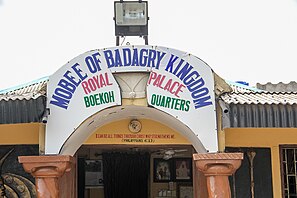
Royal Palace of Mobee of Badagry

Badagry (February 1851)[35]

Nigeria's first Christian Mission in Badagry. This is located at the museum of slavery.

Seriki Faremi Abass Slave Museum, Badagry
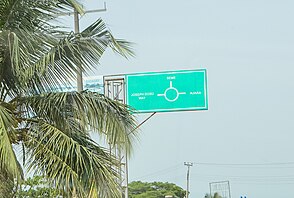
Seme Route

Slave Port Badagry
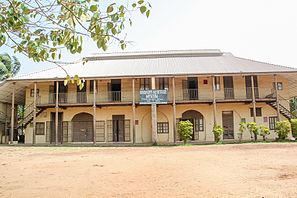
The First Administrative Building, Badagry, Lagos


The first story building in Nigeria

Badagry heritage museum model, Badagry, Lagos

Badagry heritage museum stone, Badagry, Lagos
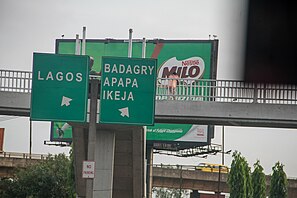
Badagry, Apapa, Ikeja landmark
References[]
- ^ "Badagry | Nigeria". Encyclopedia Britannica. Retrieved 2021-08-01.
- ^ The area is led by a traditional king, Akran De Wheno Aholu Menu - Toyi 1, who is also the permanent vice-chairman of obas and chiefs in Lagos State. Federal Republic of Nigeria Official Gazette, published 15 May 2007, accessed 8 July 2007
- ^ Sorenson-Gilmour 1995, p. II, 3.
- ^ Sorenson-Gilmour 1995, p. 2-3.
- ^ Jump up to: a b c Harris, Lynn (2017). Sea ports and sea power: African maritime cultural landscapes. Cham. ISBN 9783319469850.
- ^ "Seasonal distribution and richness of fish species in the Badagry Lagoon, south-west Nigeria | Request PDF". ResearchGate. Retrieved 2020-07-11.
- ^ Sorensen-Gilmour 1995, p. 38-40.
- ^ Jump up to: a b c d e f g h i j k l m Sorensen-Gilmour, Caroline (1995). Badagry 1784-1863. The Political and Commercial History of a Pre-Colonial Lagoonside Community in South West Nigeria (PhD). University of Stirling.
- ^ "Badagry Festival | Hometown.ng™". 2016-12-09. Retrieved 2021-08-02.
- ^ "Badagry Festival | Hometown.ng™". 2016-12-09. Retrieved 2021-08-02.
- ^ SorensenGilmour 1995, p. 135-137.
- ^ Sorensen-Gilmour 1995, p. 37-40.
- ^ Sorensen-Gilmour 1995, p. 35-40.
- ^ Sorensen_Gilmour 1995, p. 5-6.
- ^ Sorensen-Gilmour 1995, p. 54.
- ^ Sorensen-Gilmour 1995, p. 55-57.
- ^ Jump up to: a b Law, Robin (1978). "THE CAREER OF ADELE AT LAGOS AND BADAGRY, c. 1807 - c. 1837". Journal of the Historical Society of Nigeria. 9 (2): 35–59. ISSN 0018-2540. JSTOR 41857061.
- ^ Sorenson-Gilmour 1995, p. 9.
- ^ Sorensen-Gilmour 1995, p. 196-200.
- ^ Sorensen-Gilmour 1995, p. 11.
- ^ Sorensen-Gilmour 1995, p. 58.
- ^ Jump up to: a b c Aladeojebi, Gbade. (2016). History Of Yoruba Land. Partridge Publishing. ISBN 978-1-4828-6248-5. OCLC 1147867988.
- ^ Sorensen-Gilmour 1995, p. 215.
- ^ Sorensen-Gilmour 1995, p. 234.
- ^ Fọlayan, Kọla (1969). "The Career of Thomas Tickel in the Western District of Lagos, 1854-1886". Journal of the Historical Society of Nigeria. 5 (1): 27–46. ISSN 0018-2540. JSTOR 41856821.
- ^ Jump up to: a b Kunnuji, Joseph (2017). "Guided syncretism: repackaging Badagry-Ogu music in the context of Lagos' postcolonial modernity". African Music. 10 (3): 79. doi:10.21504/amj.v10i3.2197. Retrieved 13 November 2018.
- ^ Jump up to: a b c Lagos State (Nigeria); Ministry of Information and Culture; Public Information Department (1991). Focus on [name of administrative division. Ikeja: The Dept. OCLC 32240791.
- ^ "Lagos hosts Badagry heritage festival". The Sun Nigeria. 2019-12-04. Retrieved 2020-07-11.
- ^ "Day Zangbeto Festival shut down Badagry". The Sun Nigeria. 2020-01-24. Retrieved 2020-07-11.
- ^ Eruotor, Victor (2014). "THE ECONOMIC IMPORTANCE OF TOURISM IN DEVELOPING COUNTRIES: case study, Lagos Nigeria". www.Theseus.fi. Retrieved 2020-07-12.
- ^ "Sanwo-Olu seeks Badagry, Lekki Seaports' approval". Punch Newspapers. Retrieved 2021-02-06.
- ^ "Badagry Slave Route: Slaves passed these 5 notable stops on their journey of no return". Punch.
- ^ "I visited Nigeria's first storey building and found something interesting no one ever talks about". Pulse.
- ^ "Badagry Slave Route: Slaves passed these 5 notable stops on their journey of no return". Pulse.
- ^ "Badagry". Wesleyan Juvenile Offering. London: Wesleyan Mission-House. VIII: 12. February 1851. Retrieved 30 November 2015.
External links[]
| Wikivoyage has a travel guide for Badagry. |
- Local Government Areas in Lagos State
- Populated coastal places in Lagos State
- Local Government Areas in Yorubaland
- Historic districts













